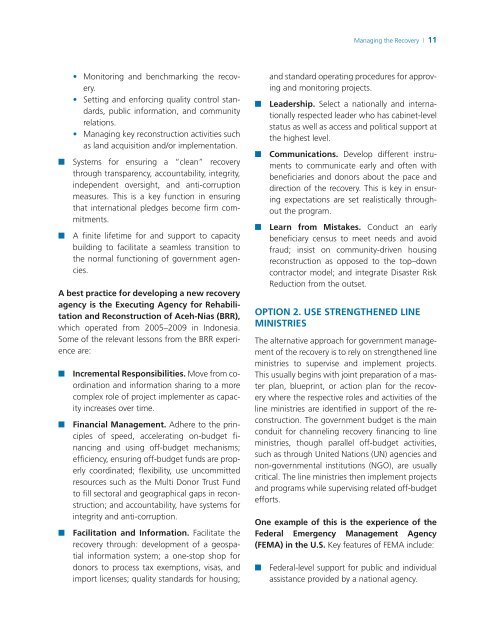Haiti Earthquake Reconstruction Knowledge Notes from ... - GFDRR
Haiti Earthquake Reconstruction Knowledge Notes from ... - GFDRR
Haiti Earthquake Reconstruction Knowledge Notes from ... - GFDRR
You also want an ePaper? Increase the reach of your titles
YUMPU automatically turns print PDFs into web optimized ePapers that Google loves.
Managing the Recovery | 11<br />
• Monitoring and benchmarking the recovery.<br />
• Setting and enforcing quality control standards,<br />
public information, and community<br />
relations.<br />
• Managing key reconstruction activities such<br />
as land acquisition and/or implementation.<br />
■■ Systems for ensuring a “clean” recovery<br />
through transparency, accountability, integrity,<br />
independent oversight, and anti-corruption<br />
measures. This is a key function in ensuring<br />
that international pledges become firm commitments.<br />
■■ A finite lifetime for and support to capacity<br />
building to facilitate a seamless transition to<br />
the normal functioning of government agencies.<br />
A best practice for developing a new recovery<br />
agency is the Executing Agency for Rehabilitation<br />
and <strong>Reconstruction</strong> of Aceh-Nias (BRR),<br />
which operated <strong>from</strong> 2005–2009 in Indonesia.<br />
Some of the relevant lessons <strong>from</strong> the BRR experience<br />
are:<br />
■■<br />
■■<br />
■■<br />
Incremental Responsibilities. Move <strong>from</strong> coordination<br />
and information sharing to a more<br />
complex role of project implementer as capacity<br />
increases over time.<br />
Financial Management. Adhere to the principles<br />
of speed, accelerating on-budget financing<br />
and using off-budget mechanisms;<br />
efficiency, ensuring off-budget funds are properly<br />
coordinated; flexibility, use uncommitted<br />
resources such as the Multi Donor Trust Fund<br />
to fill sectoral and geographical gaps in reconstruction;<br />
and accountability, have systems for<br />
integrity and anti-corruption.<br />
Facilitation and Information. Facilitate the<br />
recovery through: development of a geospatial<br />
information system; a one-stop shop for<br />
donors to process tax exemptions, visas, and<br />
import licenses; quality standards for housing;<br />
■■<br />
■■<br />
■■<br />
and standard operating procedures for approving<br />
and monitoring projects.<br />
Leadership. Select a nationally and internationally<br />
respected leader who has cabinet-level<br />
status as well as access and political support at<br />
the highest level.<br />
Communications. Develop different instruments<br />
to communicate early and often with<br />
beneficiaries and donors about the pace and<br />
direction of the recovery. This is key in ensuring<br />
expectations are set realistically throughout<br />
the program.<br />
Learn <strong>from</strong> Mistakes. Conduct an early<br />
beneficiary census to meet needs and avoid<br />
fraud; insist on community-driven housing<br />
reconstruction as opposed to the top–down<br />
contractor model; and integrate Disaster Risk<br />
Reduction <strong>from</strong> the outset.<br />
OPTION 2. USE STRENGTHENED LINE<br />
MINISTRIES<br />
The alternative approach for government management<br />
of the recovery is to rely on strengthened line<br />
ministries to supervise and implement projects.<br />
This usually begins with joint preparation of a master<br />
plan, blueprint, or action plan for the recovery<br />
where the respective roles and activities of the<br />
line ministries are identified in support of the reconstruction.<br />
The government budget is the main<br />
conduit for channeling recovery financing to line<br />
ministries, though parallel off-budget activities,<br />
such as through United Nations (UN) agencies and<br />
non-governmental institutions (NGO), are usually<br />
critical. The line ministries then implement projects<br />
and programs while supervising related off-budget<br />
efforts.<br />
One example of this is the experience of the<br />
Federal Emergency Management Agency<br />
(FEMA) in the U.S. Key features of FEMA include:<br />
■■ Federal-level support for public and individual<br />
assistance provided by a national agency.

















